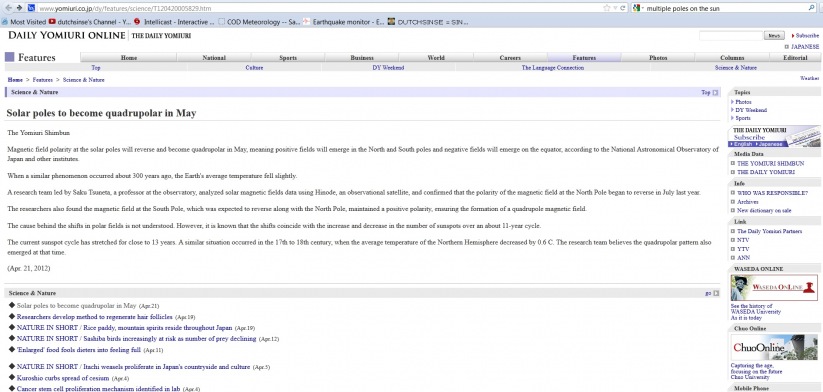
4/23/2012 UPDATE on Quadri-polar sun May 2012 polar reversal = Last occurred 300 years ago
Dutchsince
This is the new major quote that should be noted (as compared to the previous official press release article from the 19th)
“When a similar phenomenon occurred about 300 years ago, the Earth’s average temperature fell slightly.”
http://www.yomiuri.co.jp/dy/features/science/T120420005829.htm
![]()
Solar poles to become quadrupolar in May
The Yomiuri Shimbun
Magnetic field polarity at the solar poles will reverse and become quadrupolar in May, meaning positive fields will emerge in the North and South poles and negative fields will emerge on the equator, according to the National Astronomical Observatory of Japan and other institutes.
When a similar phenomenon occurred about 300 years ago, the Earth’s average temperature fell slightly.
A research team led by Saku Tsuneta, a professor at the observatory, analyzed solar magnetic fields data using Hinode, an observational satellite, and confirmed that the polarity of the magnetic field at the North Pole began to reverse in July last year.
The researchers also found the magnetic field at the South Pole, which was expected to reverse along with the North Pole, maintained a positive polarity, ensuring the formation of a quadrupole magnetic field.
The cause behind the shifts in polar fields is not understood. However, it is known that the shifts coincide with the increase and decrease in the number of sunspots over an about 11-year cycle.
The current sunspot cycle has stretched for close to 13 years. A similar situation occurred in the 17th to 18th century, when the average temperature of the Northern Hemisphere decreased by 0.6 C. The research team believes the quadrupolar pattern also emerged at that time.
(Apr. 21, 2012)screenshot of the article:
============================
some are asking IS there a difference between .. quadri , quadru, quadra … quick answer.. no difference.. all are variants of Quadri … which means four in Latin ..
http://en.wiktionary.org/wiki/quadri-
http://dictionary.reference.com/browse/quadra-
http://www.thefreedictionary.com/quadru
============================
Per the Japanese HINODE team — in about one months time — (may 2012) the suns north pole will reach a reading of “zero” and instead of a regular “pole shift” .. it will form into MULTIPLE positive poles — thus making MULTIPLE negative poles which correspond to these new “north poleS” … and to top it off.. this is happening a year ahead of the expected “nominal” time.
——————————————–
thanks to jeorgekite:
http://www.youtube.com/jeorgekite
——————————————–
download the japanese pdf here:
press_shiryo_20120418a_haihu_shiota
Here is the press release from HINODE Japan:
http://hinode.nao.ac.jp/news/120419PressRelease/index_e.shtml
screenshot below plus original article:
Polar Field Reversal as observed with Hinode
19 April 2012
Naional Astronomical Observatory of Japan (NAOJ/NINS)
RIKEN
Japan Aerospace Exploration Agency(JAXA)
National Aeronautics and Space Administration (NASA)
Science and Technology Facilities Council(STFC)
European Space Agency(ESA)
The polarity of the extended uni-polar magnetic field in the solar polar region is known to reverse every 11 years, and the reversal occurs at around the maximum of solar activity, which is expected to take place at around 2013 May (NOAA ).
High latitude magnetic fields have been observed with solar telescopes on the ground. However, actual process of the polar field reversal is poorly understood because of the difficulty of the observations on the extreme limb combined with atmospheric seeing effect. The solar optical telescope aboard the Hinode satellite allows us for the first time to perform extremely high-quality observations of the deep polar region of the Sun (Figure A). The initial discoveries include that there are many magnetic patches with intense magnetic field in the polar regions. Their field strength is close to that of sunspots, and their size is as large as small sunspots called pore.
The international research team led by Saku Tsuneta, a professor at NAOJ, has been performing the monthly polar observations with Hinode from September 2008. We here report the discovery that the average magnetic flux of the north polar region is rapidly and steadily decreasing during the period of 2008 and 2012 (Figure B). The reversal (from minus to plus polarity) is taking place in sequence from lower latitude to higher latitude. The average magnetic flux of the polar region soon becomes zero. The estimated completion of the reversal of the north polar region will take place in 1 months or so, about one year earlier than the nominal expected reversal time.
In striking contrast to the north polar situation, the magnetic flux of the south polar region has been very stable, and maintains the plus polarity (Figure C). These latest Hinode observations suggest that the global magnetic field of the Sun will become different from the normal bipolar configuration.
Observations of the polar magnetic fields are the key for understanding the cyclic solar dynamo. Their results will shed light on the origin of the solar magnetism, and will contribute to our understating on the Sun’s effect to the solar-terrestrial environment.
Figure A:
The magnetic landscape of the sun’s polar region taken on Sep. 2007 (left) and Jan. 2012 (right).
Figure B:
The close up view near the north pole 70-85 degrees, taken on Sep. 20 2008 (left) and Oct. 9 2011 (right).
Figure C:
The close up view near the south pole 70-85 degrees, taken on Mar. 20 2009 (left) and Mar. 24 2011 (right).
VIEW VIDEO HERE







